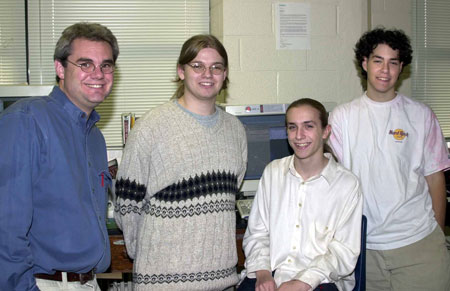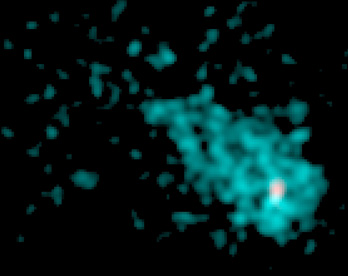Imagine the Universe News - 3 January 2001
STUDENTS FIND ELUSIVE PULSAR
| 03 January 2001 |
Special Contribution to the Imagine News
Desk
by Kathryn Fromson,
a student at North Carolina School
of Science and Math
Three high school students won first place in the national Siemens-Westinghouse Science and Technology Competition for their discovery of a spinning neutron star, or pulsar. Their unique access to data from NASA's Chandra X-ray Observatory X-ray Observatory allowed them to prove the existence of a pulsar that professionals had not been able to positively identify, despite extensive studies.
Christopher Clearfield, Charles Olbert, and Nikolas Williams, who all attend the North Carolina School of Science and Mathematics, were contracted to do research on the IC443 supernova remnant by Dr. Jonathan Keohane, a physics professor at the school. This was an extension of Keohane's earlier work studying the same remnant, in which he could not prove the existence of a pulsar because it had never been observed to pulse.

Dr. Jonathan Keohane with students Nik
Williams, Chuck Olbert, and Chris Clearfield
(Photo Credit: Loren
Winters, NCSSM)
"The experience of doing new and relevant science has been one of the most rewarding experiences I have ever had," said Olbert.
The students presented their findings at the Siemens-Westinghouse scholarship competition in Washington, D.C., where they won first place.
The students, from diverse regions of North Carolina, lived together over the summer to complete their analysis. They often called the Chandra support personnel at the Smithsonian Astrophysical Observatory for consultations on data analysis and calibration.
"The kids did all the real work," said Keohane. "I just provided data and funding and answered some questions."
The students first presented their work at a scientific meeting at the University of Maryland, wrote a scientific paper for the Astrophysical Journal, and survived several stages of the Siemens-Westinghouse contest before winning the finals on December 11, 2000.
Pulsars are named and known for their characteristic pulsing, so much so that their first observer, Jocelyn Bell, thought that the pulsing radio signals could be signs of extraterrestrial life and called them Little Green Men. So how would it be possible to prove the existence of a pulsar like the one in IC443 that refuses to pulse? The answer is a standard one in science: better technology.

Chandra image of supernova
remnant IC443.
The yellow point in the middle of the remnant is the
neutron star.
Even though 30,000 years does not sound very young, it is in terms of pulsar ages. An older pulsar is often nowhere near the remains of its supernova, because it has been traveling for a very long time. It is usually only younger pulsars, like the one in IC443, that are still in the vicinity of their supernova.
Chandra is perfect for pulsar hunting because it is so powerful that it could be used to clearly see a dime four miles away. The information from the telescope is transmitted in the form of huge data files. The data in the files are then translated into the equivalent of population-density maps of the sky. Different maps show where photons of different energy levels hit, and brighter areas on these maps indicate areas with more photons. The next step is taking the maps and making three-dimensional images of the objects that are actually in space.
To do this, the team used an image processing program called AIPS, which smoothes the edges of the pixels on the map. This smoothing creates a picture that we can actually look at and understand, unlike the photon maps. Radio-wave data was also used to help with image creation. Finally, the team did numerical guesswork to interpret the images. The pictures show a point source with lower energy X-rays and a comet-like tail with higher energy X-rays, direct evidence of a pulsar.
Clearfield, Olbert, and Williams attend the N.C. School of Science and Mathematics, a residential, state university-affiliated high school in Durham, N.C., for students with a high aptitude and interest in math and science. The students will share the Siemens-Westinghouse $100,000 scholarship award.

